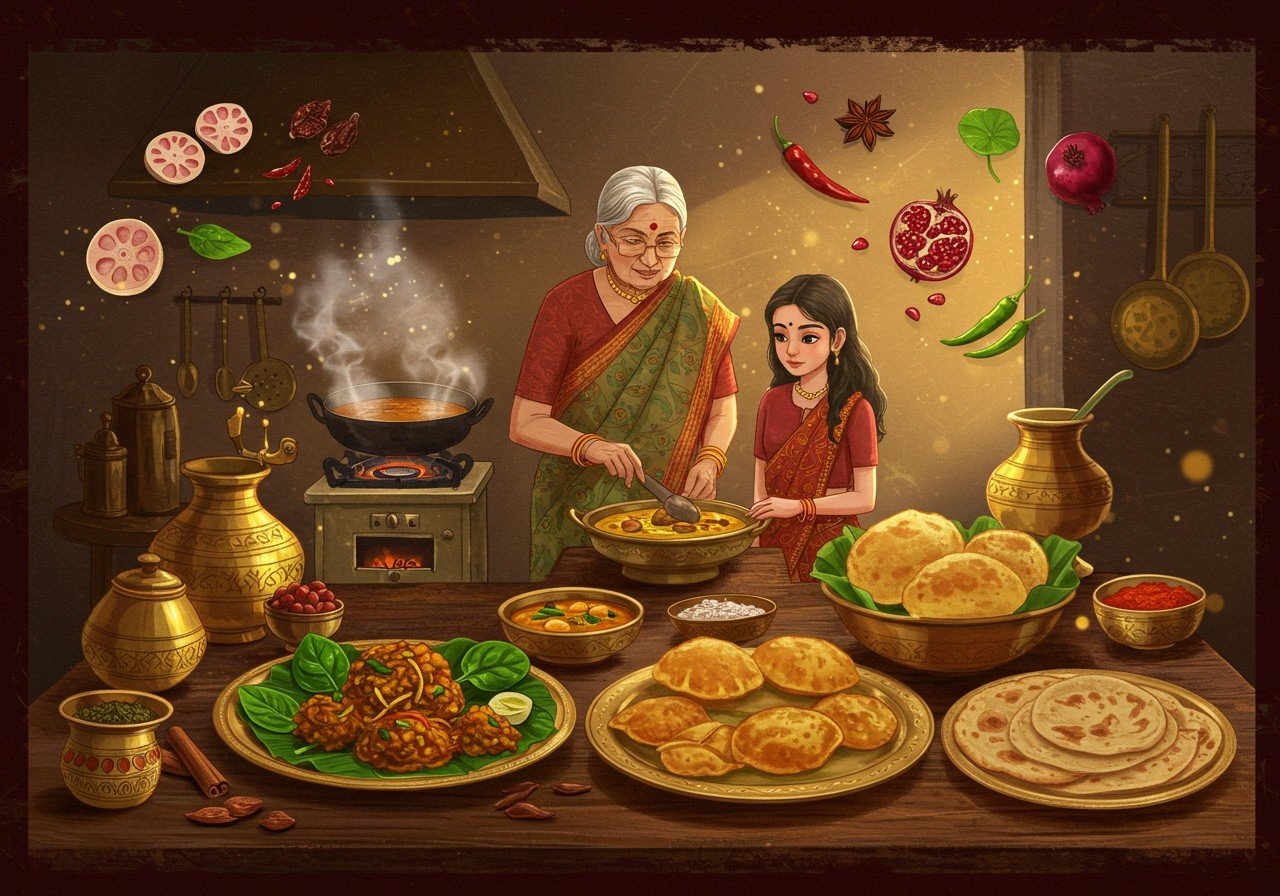
Sindhi Hindu cuisine is a vibrant tapestry of flavors and traditions, deeply woven into the fabric of history. This culinary heritage is inextricably linked to the Partition of India in 1947, a period of immense upheaval that witnessed the migration of numerous Sindhi Hindus from Sindh to India. Food emerged as a powerful instrument for preserving cultural identity, a tangible link to their ancestral heritage amidst the displacement. Traditional dishes became more than just meals; they evolved into narratives, recounting the community’s resilience and journey.
Beloved Sindhi Hindu Dishes
Let’s explore some of the iconic dishes that define Sindhi Hindu cuisine:
- Dal Pakwan: This beloved breakfast dish features crispy, flaky flatbreads (pakwan) served alongside flavorful, spiced lentils (dal). It transcends mere sustenance, symbolizing a cherished communal experience, uniting families around the dining table. You can find premium lentils for your Dal Pakwan at Poojn.in’s Holy Food section.
- Sindhi Kadhi: A tangy and spicy curry, Sindhi Kadhi is crafted with gram flour and an array of vegetables. It’s a quintessential dish for festivals and family gatherings, a symbol of joyous celebrations and togetherness. Enhance the flavor of your Sindhi Kadhi with pure ghee from Poojn.in.
- Sai Bhaji: This wholesome and nutritious dish combines spinach and lentils, reflecting the emphasis on health and vegetarianism that are deeply embedded within Sindhi Hindu dietary customs. Looking for high-quality lentils? Explore Poojn.in’s range.
- Sindhi Biryani: A symphony of aromatic spices and fragrant vegetables, Sindhi Biryani showcases influences from neighboring regions, enriching the cuisine with its diverse flavors. Find the perfect spices for your Biryani at Poojn.in.
- Bhugal Bhee (Lotus Root): The inclusion of Bhugal Bhee highlights the resourcefulness and adaptability of the community, using locally available ingredients to create unique dishes.
- Mitho Lolo: A sweet flatbread, Mitho Lolo holds special significance in religious rituals and festivals. Its sweetness symbolizes blessings and auspicious occasions.
Unique spices like ‘Sindhi masala’ and tangy chutneys like ‘tamatar kasundi’ enhance the distinctive flavors that characterize Sindhi Hindu dishes. These recipes are more than just instructions for cooking; they are culinary heirlooms, carefully passed down through generations, safeguarding a vibrant gastronomic heritage.
The Enduring Impact of the 1947 Partition
The year 1947, marked by the Partition of India, was a watershed moment for numerous communities, including the Sindhi Hindus. Compelled to leave their ancestral homeland of Sindh, which became part of Pakistan, they carried with them not only their personal belongings but also the invaluable treasure of their culinary traditions. Food transformed into a vital cultural anchor for these displaced families, preserving their customs and maintaining a connection to their roots.
Food: A Tapestry of Cultural Memory
For Sindhi Hindus, food transcends mere sustenance; it’s a profound connection to their past, a tangible reminder of the homeland they left behind. Every dish is a narrative, imbued with memories of resilience, adaptation, and the enduring spirit of their community. Food became a language of its own, expressing emotions and experiences that words alone could not capture.
Loss and Longing: A Culinary Nostalgia
Leaving Sindh also meant bidding farewell to familiar ingredients and the cherished flavors of home. This separation evoked a deep sense of longing for the tastes of their childhood. Replicating these flavors in their new surroundings proved challenging, as certain ingredients were scarce or unavailable, leading to feelings of loss and a poignant nostalgia for the culinary landscape of their homeland.
Adaptation and Innovation: A Culinary Renaissance
Amidst these challenges, Sindhi cuisine in India blossomed into a testament to the community’s remarkable adaptability. They embraced innovation, skillfully adjusting their recipes to accommodate the available ingredients while preserving the essence of their culinary heritage. This resourcefulness is evident in dishes like Dal Pakwan and Sindhi Kadhi, where tradition harmoniously coexists with innovation. Explore authentic Sindhi ingredients at Poojn.in.
Preserving Recipes: A Culinary Legacy
In the face of displacement and change, safeguarding traditional recipes became paramount. Sindhi families meticulously documented and transmitted their culinary wisdom to successive generations. This dedication ensured the survival and flourishing of their rich heritage, a legacy that continues to thrive despite geographical and cultural transitions.
Signature Sindhi Dishes: A Culinary Identity
Certain dishes have become synonymous with Sindhi cuisine, representing the community’s culinary identity:
- Dal Pakwan: A cherished breakfast staple featuring crispy flatbreads served with flavorful spiced lentils.
- Sindhi Kadhi: A tangy, aromatic curry often gracing festive occasions.
- Koki: A wholesome flatbread, a testament to simplicity and flavor.
- Bhee Patata (Lotus Root with Potatoes): A dish showcasing the community’s culinary creativity and use of local ingredients. Purchase premium quality potatoes for your Bhee Patata from Poojn.in’s Holy Food selection.
The Sindhi Papad Industry: A Culinary Enterprise
In Ulhasnagar, near Mumbai, the Sindhi papad industry emerged as a symbol of hope and resilience. It not only provided livelihoods for numerous Sindhi migrants but also played a crucial role in preserving their culinary identity. Today, Sindhi papads are renowned for their distinctive flavor and crispness, a testament to the entrepreneurial spirit of the community. You can buy authentic Sindhi papads on Poojn.in holy food category.
Poojn.in: Your Partner in Preserving Sindhi Culinary Traditions
At Poojn.in, we deeply appreciate the significance of authentic ingredients in Sindhi Hindu cuisine. Our dedicated Holy Food section offers a curated selection of essential items integral to both Sindhi cooking and religious practices. We are committed to providing pure, high-quality ingredients, conveniently delivered to your doorstep.
To cater to your Sindhi culinary needs, we offer:
- Pure ghee, essential for traditional Sindhi delicacies like Dal Pakwan and Sindhi Kadhi. Buy pure ghee here.
- Premium dry fruits, perfect for prasad and festive dishes, adding a touch of richness and tradition to your celebrations. Buy premium dry fruits here.
- Sacred ingredients for religious ceremonies, ensuring the authenticity and sanctity of your rituals. Buy sacred ingredients here.
Shopping with us is easy:
- Visit www.poojn.in
- Explore our Holy Food category
- Choose the items you need
- Place your order and enjoy convenient home delivery
Need help choosing the right ingredients? Reach out to us:
- Phone: 03369029784
- WhatsApp: 9476142738
At Poojn.in, we guarantee that all our products adhere to stringent quality standards and are packaged with care for safe delivery. We ship across India, making it convenient for you to uphold your culinary traditions wherever you are. Visit our store at Boardangi, East Belbari, Belbari, Gangarampur, South Dinajpur, or shop online at www.poojn.in for authentic ingredients for your treasured Sindhi recipes.
A Culinary Heritage: A Celebration of Resilience
Sindhi Hindu cuisine is far more than a mere collection of recipes; it is a living testament to a community’s unwavering strength, unity, and enduring spirit. Through each meal, Sindhi Hindus honor their past, celebrate their resilience, and generously share their vibrant culture with the world. As we savor the exquisite flavors of Dal Pakwan, Sindhi Kadhi, Koki and Bhee Patata, we become part of a rich tradition that transcends geographical boundaries and the passage of time. This culinary journey not only keeps the Sindhi legacy alive but also serves as a powerful reminder of food’s remarkable ability to connect us with our roots and with one another.
FAQs: Exploring the Culinary Tapestry of Sindhi Hindu Cuisine
What are some must-try Sindhi Hindu dishes? Several iconic dishes exemplify Sindhi Hindu cuisine, such as the flavorful Sindhi Kadhi, the crispy delight of Dal Pakwan, the wholesome Sai Bhaji, and the simple yet satisfying Koki. These dishes offer a delightful introduction to the rich tapestry of Sindhi flavors.
How did the 1947 Partition shape Sindhi Hindu culinary practices? The 1947 Partition led to the dispersal of Sindhi Hindus across various parts of India. This migration influenced their cuisine by introducing regional ingredients and culinary techniques. Despite these adaptations, the community remarkably preserved the core elements of their traditional recipes, creating a unique blend of old and new.
What key ingredients characterize Sindhi Hindu cooking? Staples of Sindhi Hindu cuisine include gram flour, tamarind, fragrant curry leaves, and a variety of lentils and vegetables. The cuisine also relies heavily on spices like cumin, coriander, and turmeric, which contribute to its distinctive flavor profile.
Are there specific dietary customs within Sindhi Hindu culture? Vegetarianism is a prominent aspect of Sindhi Hindu culture, with a strong emphasis on plant-based foods. While vegetarian dishes dominate, some non-vegetarian options are also part of the culinary tradition, reflecting the diversity within the community.
What cultural significance does food hold in Sindhi Hindu society? In Sindhi Hindu culture, food transcends mere nourishment. It symbolizes hospitality, tradition, and the importance of family and community. Shared meals are an integral part of festivals and ceremonies, strengthening social bonds and fostering a sense of belonging.
How do festivals influence Sindhi Hindu cuisine? Festivals play a pivotal role in Sindhi Hindu cuisine, each occasion calling for special dishes with cultural and religious significance. From Diwali to Holi and Teejri, festivals are celebrated with culinary offerings that reflect the spirit of the occasion.
Can Sindhi Hindu cuisine be adapted to suit contemporary palates? Absolutely! Sindhi Hindu cuisine can be adapted to modern tastes by incorporating healthier ingredients and cooking methods without compromising the traditional flavors that define its essence. This adaptability allows the cuisine to evolve while retaining its cultural roots.


